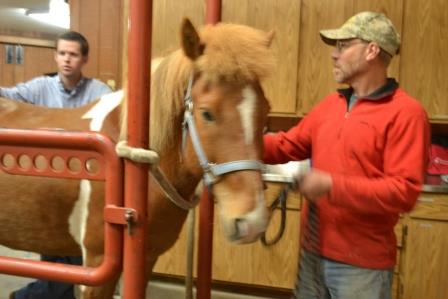
Home > Dispatches > Daily Dispatches 2014 > Daily Dispatch #147
May 28, 2014: Horse Care: Lifre’s Fate
Today was the day all who know Lifre have been waiting for. Which is, the day of his scheduled veterinary exam. Lifre has weepy holes in his abdominal area, so I scheduled an appointment at the Chugiak Veterinary Clinic. This clinic is the only one like it in the state. It’s a beautiful facility, and has a well-trained and caring staff. Dr. Mat Witzell, DVM, did the exam. I liked him – he immediately impressed me as being professional, meticulous, caring, and interested in determining why Lifre has this condition. He was also very patient in dealing with Pete, Terry (current owner), and me as we |
|
| attempted to figure out what happened, and what to do about it. There is a lot to consider in such instances, especially when one person is the horse’s owner and the other two are that horse’s caretakers. Dr. Witzell began the exam by having us put Lifre in a stock in the clinic. Lifre let it be known that he wanted to be with his buddy Tinni by neighing loudly and shifting his weight about. Dr. Witzell then gave him Dormozadan, which is a sedative. Lifre then began acting like a regular Icelandic horse. He next shaved Lifre’s underside, so that he could take a closer look at the holes. In the process, he determined that Lifre had previously had surgery, he surmised either for colic or a hernia. He deduced this upon seeing a suture line. It was his thinking that perhaps the problem was related to a previous surgeon’s using non-dissolving sutures. We all watched as he next scanned the area with an ultrasound – Dr. Witzell then pointed out dark spots –this, we learned, was infected tissue. The question then, that we all considered, was when did Lifre have this surgery and why? Unfortunately, we don’t know, and probably won’t ever know, exactly what happened. Lifre’s breeder told me that he went off to his new home having no problems of any sort. And his then owner told Terry, his new owner, that he came to him with the problem. What I do know is that the previous owner did once have the horse stitched up. This was after he cut his belly while bushwhacking. (I was on that ride.) As Dr. Witzell said, what’s important is what’s going on now. He told Terry that he’d like to go in, clean up the infected area, and if need be, remove the stitches. Terry was, at that moment, undecided about what to do – as she said, she wants what’s best for the horse. The plan is now for Lifre to be on antibiotics twice a day for 30 days, then go in for surgery. After, he’ll go back to Terry’s, where she will then tend to him. While here, Pete’s going to continue to ride him. I’m glad that the situation is being taken care of. Lifre is indeed a lucky fellow. |
|
